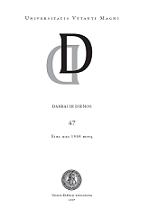Lietuvos katalikų bažnyčios dvasininkai kgb objektyve: verbavimo tikslai, ypatumai ir formos
Lithuanian catholic priests targeted by the kgb: purposes, forms and circumstances of recruitment
Author(s): Valdas PruskusSubject(s): Christian Theology and Religion
Published by: Vytauto Didžiojo Universitetas
Keywords: Lithuanian; catholic; priests; target; kgb; purposes; form; circumstances; recruitment;
Summary/Abstract: The Soviet government fought against the Lithuanian Catholic Church, considering the Church a serious obstacle to achieving its ambitious goal of an atheist Lithuania. The government enlisted the help of the special services (KGB), which used dual methods of coercion, external, such as the persecution of priests and the closing of churches (converted to secular quarters) and internal. Internal measures included the recruitment of priests for the purpose of gathering information about the priesthood and the Church. In this way the government hoped to influence and controls the Church from the inside. The strategy of undermining religious institutions through informers was customary practice in the Soviet Union. However, in Lithuania it acquired a special significance. Because of historical circumstances, methods of recruitment changed from one period to another. In 1945-1960 most of the attention was paid to recruiting the hierarchs. If the special services failed to recruit a bishop, they could turn to a priest connected with the partisan movement. There were few priests who could withstand the brutal methods of the secret services; their links with the KGB were generally noticed by both believers and colleagues. Suspected priests had to constantly change their workplace and residence, some were sent by the security services to other republics of the Soviet Union. From 1956 to 1970 a great deal of attention was also paid to the young men who wanted to enter the seminary. The KGB had important leverage in its hands: it fully controlled the entrance of students to the only seminary that remained open, in Kaunas. By supporting and helping to advance the careers of those who agreed to cooperate, security services tried to influence both the local heads of the Church and the Vatican. From 1970 to 1989 efforts to recruit priests continued, but they did so under conditions of lesser leverage. After a meeting in Helsinki in 1972, relations between Moscow and the Vatican became more conciliatory; greater numbers of young men were allowed to study for the priesthood. Methods of recruiting had to change also; even though they became less brutal, moral pressure in the form of blackmail came into practice. The KGB resorted to three modes of recruitment: ongoing or permanent service for the KGB, onetime, and random cooperation. There is no doubt that this cooperation adversely affected the authority of the Church; the unity of the Church suffered also. Jealousy and tensions provoked by the secret services arose between the dissident priests and the collaborators (the "crawlers"). On the other hand, even though cooperation with the KGB was judged unfavorably, one cannot say that it was all evil. One can suggest that in a way cooperation lessened the force of the brutal measures being used against the Church. In Lithuania churches were not destroyed to the degree they were in the other republics of the Soviet Union.
Journal: Darbai ir dienos
- Issue Year: 2007
- Issue No: 47
- Page Range: 183-199
- Page Count: 17
- Language: Lithuanian

